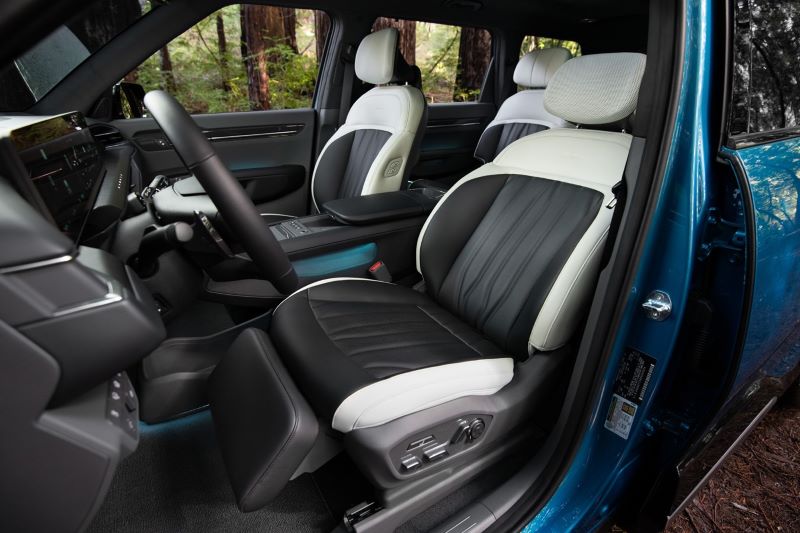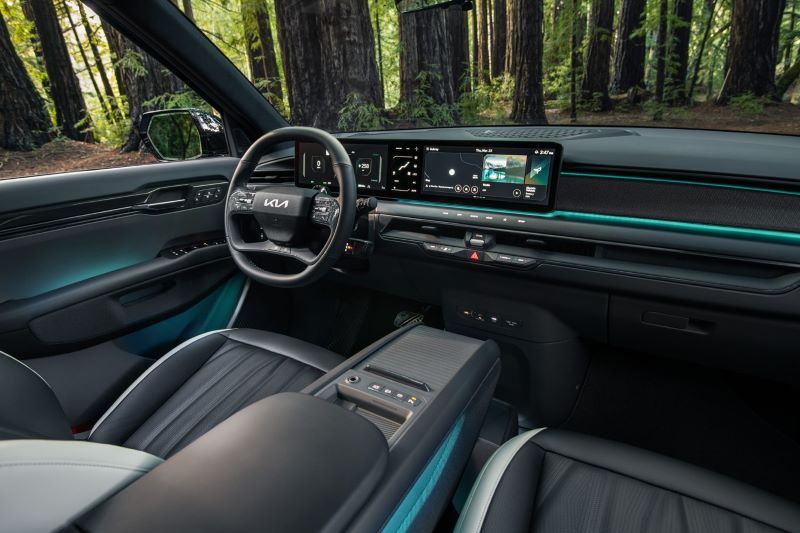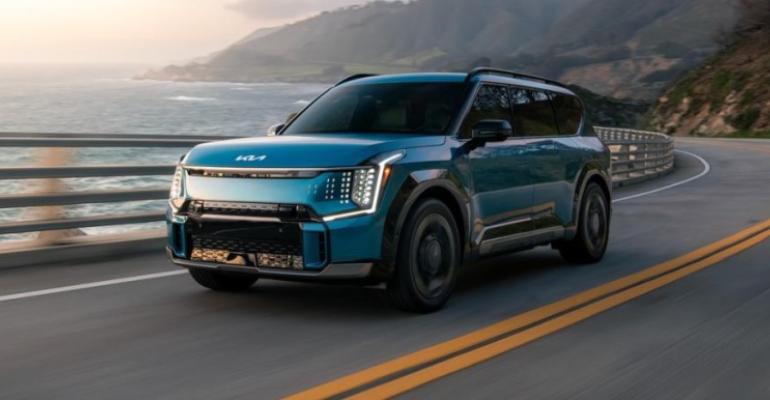NEW YORK -- Perhaps the last segment of the automotive market transitioning to battery-electric to get widespread acceptance will be family-hauling minivans and SUVs. But Kia is getting there faster than rivals with the 3-row, all-electric EV9 SUV making its debut this week at the New York auto show.
Big family haulers are expected to be the last of the segments to go widely electric because of the worry by parents over electric range and getting stuck with an empty battery and anxious kids on the way to a game, recital or grandma’s house. The theory is that busy parents and heavily scheduled kids will need a much better and more reliable recharging infrastructure to be completely sold on EVs, despite the more favorable support of EV s by Generation Z than their parents.
Kia is calling the EV9, which has a 300-mile (483-km) battery range, the flagship of its global Plan S strategy--offering 11 EVs by 2025, targeting a 6.6% global EV market share--as well as “a pioneer in its segment and the automotive industry.”
“Sixty-seven percent of our sales in the U.S. are SUVs, so it makes sense for us to put ourselves out there with a great SUV that is an EV now,” said Kia USA Chief Center said there would be some overlap between the lower trim model of the EV9 and the top end of Telluride’s pricing.
The EV9 is expected to arrive in the U.S. in fourth-quarter 2023.
Developed on the E-GMP architecture dedicated to EVs with fourth-generation battery technology, the EV9 has seating for up to seven passengers, with a long wheelbase and flat floor to accommodate soccer and hockey families with all the gear they carry.
The EV9’s standard 800V electrical architecture enables ultrafast recharging on high-speed DC chargers, designed to go from a 10% to 80% state of charge in under 25 minutes.
At 197.4 ins. (5,014 mm) in length, the EV9 is slightly longer than the Telluride SUV and comparable in height (up to 70.1 ins. [1,780 mm]) and width (77.9 ins. [1,979 mm]). With all three rows raised, the EV9 offers 20.2 cu.-ft. (572 L)) of cargo space. When both rows of rear seats are folded, volume increases to 81.9 cu.-ft. (2,319 L).

EV9 Highlights
- The available Star Map LED-animated, digital pattern accent-lighting grille can be personalized by the driver as part of five dynamic welcome light formations, a first for Kia. The effect is achieved by creating a pattern of tiny perforations in the paint and allowing an LED light to shine through the holes.
- Centrally mounted, hidden-until-lit haptic switches for key infotainment features appear when the EV9 is turned on.
- The dual-level, floating center console stretches from the first to the second row, offering under-tray stowage to front passengers and cupholders and an available sliding storage console for rear passengers.
- Optional full-color head-up display for the driver.
- “Executive-class” seating including the second row of seats. Front-passenger and second-row occupants are treated to an available Relaxation Mode which offers power-operated leg rests, and second-row creature comforts include 8-way power adjustments enhanced with heating and cooling.
- First Kia model offering over-the-air updates, as well as navigation-based charging guidance using arrival time and distance-to-empty estimates.
- The EV9 also functions as a mobile power source, able to power a home’s appliance needs during blackout episodes.
- Digital key and remote-parking-assist: The key (on your smartphone) can initiate parking while the keyholder watches the EV9 park itself.
- The EV9 can be equipped with Kia’s standard and available advanced driver assistance systems (ADAS). New to this tech are advanced highway driving assist, which allows for hands-free driving in many instances and on designated highways, as well as lane-keeping. EV9 also offers Kia’s forward collision-avoidance assist (FCA). Standard FCA has been enhanced on the EV9 to, in certain circumstances, detect vehicles, pedestrians and cyclists in front of the vehicle while driving; oncoming vehicles while turning left at an intersection; and crossing vehicles while passing through an intersection. Kia says it is working on a lidar-based system called Highway Driving Pilot that will allow Level 3 autonomous driving.

The EV9 is the first Kia model to feature fourth-generation battery technology designed for improved energy density. The SUV will be available with a choice of two powertrain options: a standard 76.1-kWh battery with a 160-kW (215-hp) "lomg range" motor that drives the rear wheels (an optional 99.8-kWh battery will be available in a single-motor configuration targeting 300 miles of all-electric range), or a dual-motor, 283-kW (379-hp) torque vectoring all-wheel-drive configuration with 516 lb.-ft. (700 Nm) of torque. The more powerful drivetrain reduces the range to between 225-250. The EV9 at launch offers four drive modes on all trims: Eco, Normal, Sport, and My Mode.
One of the first things one notices about the EV9 is that it looks very much like a practical, boxy SUV, and the design of the EV looks obviously related to Kia’s successful vehicles—Telluride and Kia Soul. There are no obvious tapering of the roofline in order to over-achieve on aerodynamics for better total battery range. “We achieved efficiencies that are not obvious in order to get a very respectable .28 drag coefficient, but we decided early on that we wanted to it look very much like a Kia and in our design language—boxy, rugged and capable,” said Kurt Kahl, senior design manager at Kia.
Good for up to 300 miles of range, the EV9 should handle the daily driving needs of just about any family provided they start the day with a full charge. The anxiety for families, as well as individuals, is for longer driving trips. But highway charging infrastructure is rapidly improving, and the smartphone apps that guide EV drivers’ routes to optimize charging opportunities are also getting better.





